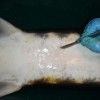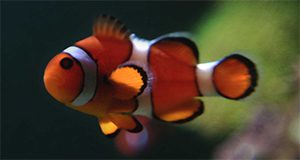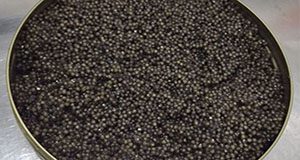Color in fish is mostly genetically determined, but they are unable to produce red, orange, yellow, green, and some blue colors themselves.They get these colors from their food. Fish raised in aquariums or recirculating water systems without pigment supplementation in their diet will fade and lose their vibrant hues. Even in ponds, dietary pigment supplementation can make fishes brighter and more variably colored, just like their wild counterparts. This 6-page fact sheet written by F. A. Chapman and R. D. Miles and published by the UF/IFAS School of Forest Resources and Conservation, Program in Fisheries and Aquatic Sciences, addresses how ornamental fish get their colors and provides a list of ingredient sources for diets that can be used to enhance and intensify fish colors.
Tag: Frank A. Chapman
Technically Speaking, What Is Sturgeon Caviar?
People all over the world eat fish and shellfish eggs. Seafood roes are among the most valuable of fishery commodities because they are considered a delicacy and sell for a high price. The eggs can be acquired as whole roe, (the eggs still attached to the ovary, as with mullet), or as individual eggs that may be collected directly from where the female deposits or spawns her eggs (for instance, “tobiko,” from flying fish), or by harvesting the female and separating the eggs from the ovary (as with salmon, lumpfish, and sturgeon “caviar”). The most sought-after and high-valued of all seafood roes are the eggs obtained from the sturgeon. Traditionally coveted by royalty and the aristocracy, sturgeon caviar today is prized by chefs and discerning food connoisseurs the world over for its delicate flavor and nutrient-rich health benefits. Learn what caviar is, find out how it’s collected, and discover more about the fascinating sturgeon fish in this 4-page fact sheet written by Frank A. Chapman and Joel P. Van Eenennaam and published by the School of Forest Resources Program in Fisheries and Aquatic Sciences.
http://edis.ifas.ufl.edu/fa194
Sturgeon Aquaculture: Specialized Techniques: Determining the Sex of Sturgeon by Direct Examination of the Gonad Using a Minimally Invasive Surgical Procedure (FA183)
 Because male sturgeon are harvested for meat at 2-4 years of age and females are retained for caviar production, being able to determine the sex of individual sturgeon has specific economical advantages. But it is difficult to tell females from males, especially when the fish are young (from hatch to 3 years old). This 5-page fact sheet describes the standard method and tools for determining the sex of sturgeon by direct examination of the gonad using a minimally invasive surgical procedure. Written by Frank A. Chapman and Joel P. Van Eenennaam, and published by the UF Department of Fisheries and Aquatic Sciences, November 2012.
Because male sturgeon are harvested for meat at 2-4 years of age and females are retained for caviar production, being able to determine the sex of individual sturgeon has specific economical advantages. But it is difficult to tell females from males, especially when the fish are young (from hatch to 3 years old). This 5-page fact sheet describes the standard method and tools for determining the sex of sturgeon by direct examination of the gonad using a minimally invasive surgical procedure. Written by Frank A. Chapman and Joel P. Van Eenennaam, and published by the UF Department of Fisheries and Aquatic Sciences, November 2012.
http://edis.ifas.ufl.edu/fa183
Sharks for the Aquarium and Considerations for Their Selection (FA179)
Sharks are magnificent animals and an exciting group of fishes. And they are becoming increasingly popular as pet animals. The proper care and display of sharks requires great attention to details. This 8-page fact sheet provides critical points aquarists must consider in deciding whether or not to include sharks in their aquaria. A table of the most popular sharks kept in public and home aquariums is provided to facilitate species selection. Written by Alexis L. Morris, Elisa J. Livengood, and Frank A. Chapman, and published by the UF Department of School of Forest Resources and Conservation Program in Fisheries and Aquatic Sciences, December 2010.
http://edis.ifas.ufl.edu/fa179
FA174 Teach Aquaculture Curriculum: Spawning and Rearing Bivalve Molluscs–Spawning
FA174, a 9-page activity by R. Leroy Creswell, Cortney L. Ohs, Craig S. Kasper, Elisa J. Livengood, Amber L. Garr, Brian E. Myers, Carlos V. Martinez, and Frank A. Chapman, is activity 12 of the Teach Aquaculture Curriculum. In this activity for grades 9-12, students will learn methods for spawning bivalve molluscs like clams or oysters using temperature manipulation. Students will use an ocular micrometer to measure the diameter of bivalve eggs and the length of bivalve larvae. Includes student performance standards. Published by the UF School of Forest Resources and Conservation, Program in Fisheries and Aquatic Sciences, May 2010.
http://edis.ifas.ufl.edu/fa174
FA173 Teach Aquaculture Curriculum: Anatomy of a Fish
FA173, a 5-page activity by Amber L. Garr, Cortney L. Ohs, Craig S. Kasper, R. Leroy Creswell, Frank A. Chapman, Brian E. Myers, Elisa J. Livengood, and Carlos V. Martinez, is activity 1 of the Teach Aquaculture Curriculum. In this activity for grades 5-12, students categorize types of fish, describe the basic biology of fish species, and identify the primary functions of anatomical features common to aquaculture. Includes student performance standards. Published by the UF School of Forest Resources and Conservation, Program in Fisheries and Aquatic Sciences, July 2010.
http://edis.ifas.ufl.edu/fa173
FA177 Teach Aquaculture Curriculum: Introduction
FA177, a 2-page fact sheet by Cortney L. Ohs, R. Leroy Creswell, Amber L. Garr, Carlos V. Martinez, Brian E. Myers, Elisa J. Livengood, Craig S. Kasper, and Frank A. Chapman, introduces the Teach Aquaculture Curriculum. The curriculum is designed to engage students in aquaculture and the aquatic sciences through a series of hands-on activities involving all the sciences, mathematics, reading, and writing. Each activity in the series includes student performance standards. Published by the UF School of Forest Resources and Conservation, Program in Fisheries and Aquatic Sciences, July 2010.
http://edis.ifas.ufl.edu/fa177
FA176 Teach Aquaculture Curriculum: Dancing with Brine Shrimp
FA176, a 7-page activity by Elisa J. Livengood, Cortney L. Ohs, Amber L. Garr, R. Leroy Creswell, Carlos V. Martinez, Craig S. Kasper, Brian E. Myers, and Frank A. Chapman, is activity 14 of the Teach Aquaculture Curriculum. In this activity for grades 5-12, students will hatch and culture brine shrimp to observe the behavior and the different development stages of the organisms. Includes student performance standards. Published by the UF School of Forest Resources and Conservation, Program in Fisheries and Aquatic Sciences, July 2010.
http://edis.ifas.ufl.edu/fa176
FA175 Teach Aquaculture Curriculum: Spawning and Rearing Bivalve Molluscs — Larval Culture
FA175, a 4-page activity by R. Leroy Creswell, Cortney L. Ohs, Craig S. Kasper, Carlos V. Martinez, Elisa J. Livengood, Amber L. Garr, Frank A. Chapman, and Brian E. Myers, is activity 13 of the Teach Aquaculture Curriculum. In this activity for grades 9-12, students learn to describe the reproductive biology and spawning of bivalve molluscs, leading to an understanding of the conditions used in hatcheries for commercial production of bivalve molluscs. Includes student performance standards. Published by the UF School of Forest Resources and Conservation, Program in Fisheries and Aquatic Sciences, July 2010.
http://edis.ifas.ufl.edu/fa175
FA172 Teach Aquaculture Curriculum: What Makes a Good Fish Food?
FA172, a 5-page activity by Craig S. Kasper, Cortney L. Ohs, Brian E. Myers, Frank A. Chapman, Amber L. Garr, R. Leroy Creswell, Carlos V. Martinez, and Elisa J. Livengood, is activity 22 of the Teach Aquaculture Curriculum. In this activity for grades 9-12, students will learn the common ingredients in fish food, design their own fish food, and discover how water stability relates to fish nutrition, production and the environment. Includes student performance standards. Published by the UF School of Forest Resources and Conservation, Program in Fisheries and Aquatic Sciences, July 2010.
http://edis.ifas.ufl.edu/fa172
FA169 Teach Aquaculture Curriculum: Fish-Eating Contest
FA169, a 4-page activity by Amber L. Garr, Cortney L. Ohs, Brian E. Myers, Craig S. Kasper, R. Leroy Creswell, Frank A. Chapman, Carlos V. Martinez, and Elisa J. Livengood, is activity 2 of the Teach Aquaculture Curriculum. In this activity for grades 5-12, students observe the external anatomy of fish to determine feeding behaviors and recommend an aquaculture diet based on their observations. Includes student performance standards. Published by the UF School of Forest Resources and Conservation, Program in Fisheries and Aquatic Sciences, May 2010.
http://edis.ifas.ufl.edu/fa169
FA170 Teach Aquaculture Curriculum: How Big Is That Pond?
FA170, a 5-page activity by Cortney L. Ohs, Amber L. Garr, R. Leroy Creswell, Elisa J. Livengood, Brian E. Myers, Carlos V. Martinez, Frank A. Chapman, and Craig S. Kasper, is activity 5 of the Teach Aquaculture Curriculum. In this activity for grades 5-12, students will learn to calculate the volume, surface area, stocking densities of fish, and chemical application amounts for various sizes of ponds. Includes student performance standards. Published by the UF School of Forest Resources and Conservation, Program in Fisheries and Aquatic Sciences, May 2010.
http://edis.ifas.ufl.edu/fa170
FA171 Teach Aquaculture Curriculum: Chlorine–Friend or Foe?
FA171, a 5-page activity by Carlos V. Martinez, Cortney L. Ohs, Brian E. Myers, Elisa J. Livengood, Craig S. Kasper, Amber L. Garr, R. Leroy Creswell, and Frank A. Chapman, is activity 18 of the Teach Aquaculture Curriculum. In this activity for grades 5-12, students determine the amount of chlorine present in tap water and use two methods to remove chlorine from water. Includes student performance standards. Published by the UF School of Forest Resources and Conservation, Program in Fisheries and Aquatic Sciences, May 2010.
http://edis.ifas.ufl.edu/fa171
FA166 Candidate Species for Florida Aquaculture: Discus Symphysodon spp., a Profitable but Challenging Species for Florida Aquaculture
FA166, an 8-page illustrated fact sheet by E. J. Livengood, C. L. Ohs, and F. A. Chapman, provides an overview of this disc-shaped freshwater chiclid fish — description, habitat and feeding, conservation issues, taxonomy, genetics and domestication, culture methods, and markets. Includes references. Published by the UF Program in Fisheries and Aquatic Sciences, School of Forest Resources and Conservation, December 2009.
http://edis.ifas.ufl.edu/fa166
FA159 Interpreting a Fish Food Package Label
FA159, a 6-page fact sheet by Frank Chapman and Richard Miles, provides farmers and pet owners a guide to interpreting the information on fish food labels. Includes references. Published by the UF Program in Fisheries and Aquatic Sciences, December 2009.
http://edis.ifas.ufl.edu/fa159
FA154/FA154 Sturgeon Aquaculture – Specialized Techniques: Determining the Stage of Sexual Maturity in Female Sturgeon for Artificial Spawning: The Egg Maturation Assay
FA-153, a 4-page illustrated fact sheet by Frank A. Chapman and Joel P. Van Eenennaam, describes a biological test to determine if sturgeon eggs are in the stage of final maturation — the principle behind the test, materials needed, and protocol. Published by the UF Department of Fisheries and Aquatic Sciences, December 2007.
http://edis.ifas.ufl.edu/FA154
FA153/FA153 Sturgeon Aquaculture – Specialized Techniques: Determining the Stage of Sexual Maturity in Female Sturgeon for Artificial Spawning: The Egg Polarization Index or PI
FA-153, a 5-page illustrated fact sheet by Frank A. Chapman and Joel P. Van Eenennaam, describes a simple field and laboratory test used to assist in predicting ovulatory response in female sturgeon, which uses the egg size and position of the nucleus in the cytoplasm as indicators — the principle behind it, materials needed, biopsy procedure, and how to determine the egg polarization index. Published by the UF Department of Fisheries and Aquatic Sciences, December 2007.
http://edis.ifas.ufl.edu/FA153

